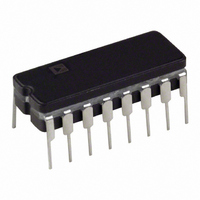AD652AQ/+ Analog Devices Inc, AD652AQ/+ Datasheet - Page 18

AD652AQ/+
Manufacturer Part Number
AD652AQ/+
Description
IC,Voltage-to-Frequency Converter,DIP,16PIN
Manufacturer
Analog Devices Inc
Type
Voltage to Frequencyr
Datasheet
1.AD652JPZ.pdf
(28 pages)
Specifications of AD652AQ/+
Rohs Status
RoHS non-compliant
Frequency - Max
2MHz
Full Scale
±50ppm/°C
Linearity
±0.02%
Mounting Type
Through Hole
Package / Case
16-CDIP (0.300", 7.62mm)
Lead Free Status / RoHS Status
AD652
This can be shown in equation form, where f
output frequency and f
The scope photo in Figure 24 shows V
and the output of the F-V (bottom trace).
SINGLE-LINE MULTIPLEXED DATA TRANSMISSION
It is often necessary to measure several different signals and
relay the information to some remote location using a mini-
mum amount of cable. Multiple AD652 SVFC devices may be
used with a multiphase clock to combine these measurements
for serial transmission and demultiplexing. Figure 25 shows a
block diagram of a single-line multiplexed data transmission
f
OUT
f =
f
f
C
OUT
OUT
= V
V
=
=
1
V
V
1
1
× V
10
1
2
MHz
V
⎛
⎜
⎜
⎜
⎜
⎝
10
2
V
2
⎛
⎜
⎜
⎝
f
2
Figure 24. Multiplier Waveforms
× 5 kHz/V
C
2
V
(
10
⎞
⎟
⎟
⎟
⎟
⎠
SHOT
1
OUT
ONE
φ
MHz
V
1
)(
is the AD652 output frequency:
GENERATOR
10
φ
2
2
CLK
V
V
)
AD652
φ
IN1
⎞
⎟
⎟
⎠
3
φ
1
4
and V
Figure 25. Single-Line Multiplexed Data Transmission Block Diagram
V
SVFC MULTIPLEXER
(SEE FIGURE 26)
AD652
IN2
C
2
is the AD654
(top two traces)
V
AD652
IN3
V
V
V
1
2
OUT
Rev. C | Page 18 of 28
(SEE FIGURE 27)
TRANSMISSION
TRANSMISSION
LINK
LINK
system with high noise immunity. Figure 26, Figure 27, and
Figure 30 show the SVFC multiplexer, a representative means of
data transmission, and an SVFC demultiplexer respectively.
Multiplexer
Figure 30 shows the SVFC multiplexer. The clock inputs for the
several SVFC channels are generated by a TIM9904A 4-phase
clock driver, and the frequency outputs are combined by
strapping all the frequency output pins together (a wire OR
connection). The one-shot in the AD652 sets the pulse width of
the frequency output pulses to be slightly shorter than one
quarter of the clock period. Synchronization is achieved by
applying one of the four available phases to a fixed TTL one-
shot (’121) and combining the output with external transistor.
The width of this sync pulse is shorter than the width of the
frequency output pulses to facilitate decoding the signal. The
RC lag network on the input of the one-shot provides a slight
delay between the rising edge of the clock and the sync pulse in
order to match the 150 ns delay of the AD652 between the
rising edge of the clock and the output pulse.
Transmitter
The multiplex signal can be transmitted in any manner suitable
to the task at hand. A pulse transformer or an opto-isolator can
provide galvanic isolation; extremely high voltage isolation or
transmission through severe RF environments can be accomp-
lished with a fiber optic link; telemetry can be achieved with a
radio link. The circuit shown in Figure 27 uses an EIA RS-422
standard for digital data transmission over a balanced line.
Figure 24 shows the waveforms of the four clock phases and the
multiplex output signal. Note that the sync pulse is present
every clock cycle, but the data pulses are no more frequent than
every other clock cycle since the maximum output frequency
from the SVFC is half the clock frequency. The clock frequency
used in this circuit is 819.2 kHz, which provides more than
16 bits of resolution if 100 ms gate time is allowed for counting
pulses of the decoded output frequencies.
DEMULTIPLEXER FREQUENCY TO
VOLTAGE CONVERSION
(SEE FIGURE 31)
φ
AD652
DEMUX
2
V
SVFC
OUT1
φ
AD652
3
V
OUT2
f1
f2
f3
SVFC DEMULTIPLEXER
(SEE FIGURE 30)
φ
AD652
4
V
OUT3












